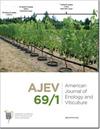Soft, Sweet, and Colorful: Stratified Sampling Reveals Sequence of Events at the Onset of Grape Ripening
IF 1.8
3区 农林科学
Q3 BIOTECHNOLOGY & APPLIED MICROBIOLOGY
引用次数: 10
Abstract
Asynchronous development of grape berries leads to high variation among berry samples collected during veraison. We applied a stratified sampling method that groups berries by firmness to the touch and visible skin color to study the sequence of physical and chemical changes occurring at the onset of and during ripening. Method robustness and reproducibility were tested by measuring berry weight, diameter, deformation, and total soluble solids (TSS) in samples collected from 10 wine, table, and juice grape cultivars varying in skin color. Additionally, Syrah berries sampled by five different individuals were compared in one year, and Syrah and Merlot berry samples and cluster images were evaluated over three years to account for environmental variation. Merlot berries collected in one year were classified into seven developmental stages to measure changes in berry weight, elastic modulus, TSS, titratable acidity (TA), pH, malate, tartrate, and anthocyanins. Stratified sampling reliably differentiated among developmental stages when applied by different individuals and in different cultivars and years. Once the berries softened, they took 11 to 14 days to complete their color change. Softening occurred mostly before sugar accumulation and renewed berry expansion began. Sugar accumulation was concurrent with malate degradation, but its onset preceded anthocyanin accumulation. The increase in TSS was closely associated with decreases in elastic modulus, TA, and malate and increases in berry weight, skin mass per area ratio, and pH. Ripening-related changes in TA and pH were strongly driven by changes in malate but not tartrate. The stratified sampling method allows novel insights into the timing of physical and chemical changes that occur in grape berries during the period commonly referred to as veraison.软,甜,多彩:分层抽样揭示了葡萄成熟开始时的事件序列
葡萄浆果的异步发育导致在veraison期间采集的浆果样本之间的高度变异。我们采用分层抽样方法,根据浆果的触感硬度和可见肤色对其进行分组,以研究成熟开始时和成熟过程中发生的物理和化学变化的顺序。方法通过测量从10个不同肤色的葡萄酒、餐桌和果汁葡萄品种采集的样品中的浆果重量、直径、变形和总可溶性固形物(TSS)来测试稳健性和再现性。此外,在一年内对五个不同个体采集的西拉浆果进行了比较,并在三年内对西拉和梅洛浆果样本和聚类图像进行了评估,以考虑环境变化。一年内采集的梅洛浆果分为七个发育阶段,以测量浆果重量、弹性模量、TSS、可滴定酸度(TA)、pH、苹果酸、酒石酸和花青素的变化。分层取样在不同个体、不同品种和年份的发育阶段之间可靠地区分。浆果软化后,它们需要11到14天才能完成颜色的变化。软化主要发生在糖积累和新的浆果膨胀开始之前。糖积累与苹果酸降解同时发生,但其发生先于花青素积累。TSS的增加与弹性模量、TA和苹果酸的降低以及浆果重量、单位面积皮肤质量比和pH的增加密切相关。TA和pH的成熟相关变化主要由苹果酸的变化驱动,而不是酒石酸的变化。分层采样方法可以对葡萄浆果在通常被称为白藜芦醇的时期发生的物理和化学变化的时间有新的见解。
本文章由计算机程序翻译,如有差异,请以英文原文为准。
求助全文
约1分钟内获得全文
求助全文
来源期刊

American Journal of Enology and Viticulture
农林科学-生物工程与应用微生物
CiteScore
3.80
自引率
10.50%
发文量
27
审稿时长
12-24 weeks
期刊介绍:
The American Journal of Enology and Viticulture (AJEV), published quarterly, is an official journal of the American Society for Enology and Viticulture (ASEV) and is the premier journal in the English language dedicated to scientific research on winemaking and grapegrowing. AJEV publishes full-length research papers, literature reviews, research notes, and technical briefs on various aspects of enology and viticulture, including wine chemistry, sensory science, process engineering, wine quality assessments, microbiology, methods development, plant pathogenesis, diseases and pests of grape, rootstock and clonal evaluation, effect of field practices, and grape genetics and breeding. All papers are peer reviewed, and authorship of papers is not limited to members of ASEV. The science editor, along with the viticulture, enology, and associate editors, are drawn from academic and research institutions worldwide and guide the content of the Journal.
 求助内容:
求助内容: 应助结果提醒方式:
应助结果提醒方式:


